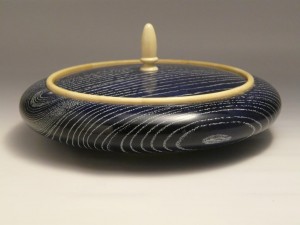The other day I received an email from a person who visited this blog then contacted me about possibly repairing a turning. She described the problem as a wooden band coming unglued at the top of the bowl and wondered if it could be reglued. I took that to be an inlayed banding detail and agreed to look at the problem.
She lives in Vancouver and had purchased a turned bowl (appears to be a salad bowl) from a woodturner in New York, hence her query to me instead of the original turner. She sent me some photos of the bowl (unfortunately I couldn’t copy them from the email) after I had said that the first step would be to determine the reason for the separation. As soon as I opened her email with the pictures I knew what had caused the problem. The loose piece wasn’t a strip of inlayed banding at all. Rather, it was the top layer of a built-up bowl. The thick-walled bowl had been constructed of laminated (not segmented) wood approximately 3/4″ – 1″ thick, the grain in each layer shifted 90 degrees away from the layers adjacent. In addition, the pith was present in one of the boards, lending anything but an artistic appearance to the piece. Obviously the differing expansion ratios between layers had finally broken the bond causing the separation. From the appearance of the finish it is possible the bowl had been washed multiple times which may have sped things up a bit. I told her there was no point repairing the damage since it would not only happen again but would likely continue until the bowl was a stack of half-rings on the table.
The contruction of this bowl was a rookie mistake that was bound to cause this problem sooner or later. The finish sanding was obviously done with 80 grit or rougher which matched the piece with the pith in it, but that’s another story. Layering wood so that the grain is alternately aligned 90 degrees to the next is bound to stess the glue joint as the wood expands and contracts. If the bowl is thin-walled, bending will probably occur, but in this case the bowl had very thick walls cauing the bond to break. Because the wood expands in width significantly more than length, each layer will fight with the next every time there is a change in humidity. If this piece had never been washed it would still have happened; it would just have taken a bit longer. I suspect there may have been another issue as well. If the built up boards were glued together as actual boards in a stack, the glue joint would have been very poor since it needs more pressure than normal shop methods of clamping will provide. Joints like that are best done two together then one added at a time after that. Only very heavy duty hydraulic presses can supply enough force to glue several pieces together at once.
There is a method of laminated turning called “bowl from a board”. This is a method of ripping a full board in half lengthwise then bandsawing half circles at an angle from the two pieces. The half circles are glued together to make full rings then restacked so that they form a conical blank, gluing them one at a time, with the joints 90 degrees apart so that each is supported by the next (obviously what this turner was trying to do). This works for two main reasons: first, it is all the same piece of wood so humidity is the same throughout so the relative expansion is reduced somewhat. Second, the walls are typically much thinner than the example I was looking at, so the glue joints are allowed to flex enough to stay together. That being said, I have seen some of these come apart as well.
Segmented turners deal with this issue in every piece they make. While attending a demo by Malcolm Tibbets I learned that to completely avoid separation due to conflicting expansion rates, the grain in all the pieces in a built up piece must always be oriented in the same way. They can be end grain or flat grain but must be all the same orientation. Each piece is of course shaped like a piece of pie within each ring – not flat boards like the high-school job that I was looking at. He suggested going one step further by turning a groove in the bottom ring to hold the bottom like a panel in a panel constructed door so that it could move freely. Malcolm brought a couple of failures that had grain in opposing directions to prove his point.

The segmented holly ring is thin enough to move with the single piece of ash used for the main body.
I am not a segmented turner at all but I do glue wood together from time to time for aesthetic reasons or to reduce waste. I turned a lidded vessel from ash with a trim ring and foot made from segmented holly. Malcolm assured me that in this case the rings were thin enough that they would flex with the movement of the main flat-grained body, so I breathed a sigh of relief – because it had already been sold. Malcolm’s lessons have paid off by making me aware of the significance of conflicting wood expansion, so hopefully someone in New York won’t be calling another turner there to repair one of my turnings.
As always, I encourage your comments and questions, so please refer to the tag line at the bottom of the article to post a comment.
